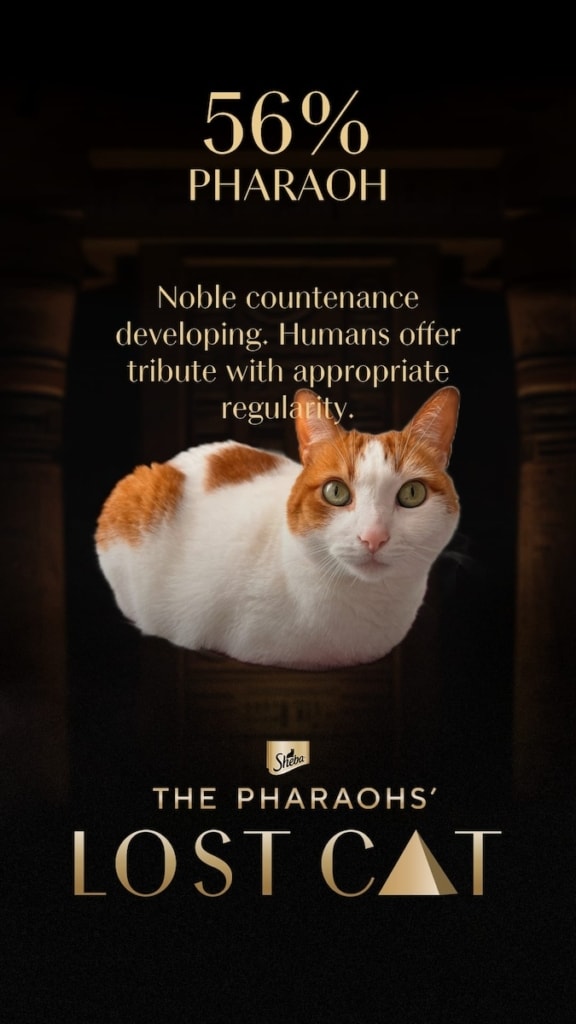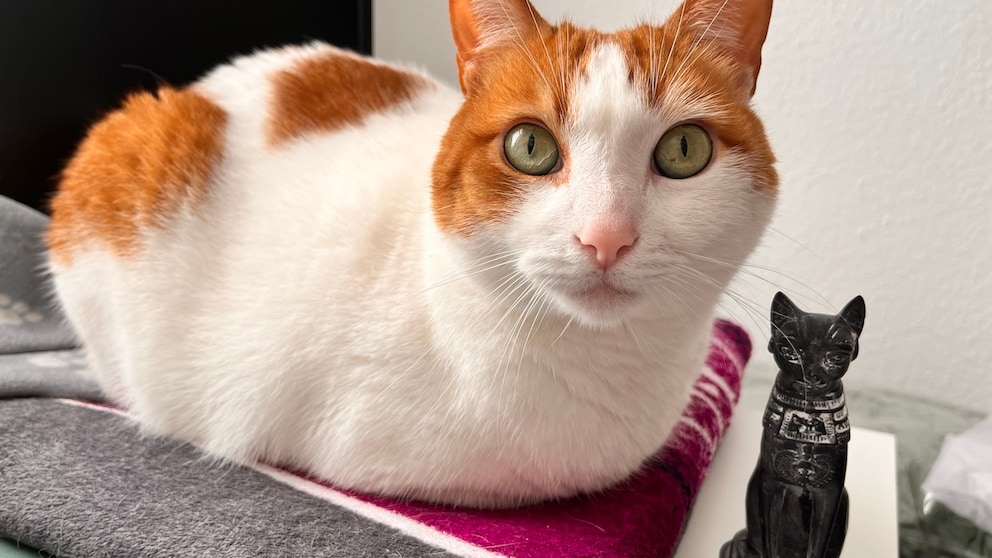April 10, 2025, 9:33 am | Read time: 7 minutes
Are our cats hiding a touch of ancient Egyptian magic and pharaonic flair? An unusual collaboration between a cat food manufacturer and a genetics researcher sheds new light on our pets. Is it all just clever marketing or real science? Cultural scientist and amateur Egyptologist Louisa Stoeffler goes in search of clues: How much DNA from ancient Egyptian predecessors do our cats still carry today?
The cat food brand Sheba has launched an unusual campaign to introduce a new type of food in keeping with its status. “The Pharaoh’s Lost Cat” is the name of the campaign, which uses an AI-supported tool to investigate whether today’s domestic cats bear traits of the animals that once lived alongside Egyptian pharaohs. Cat owners can upload a photo of their pet and receive not only an analysis by the “Pharaoh Cat Finder” tool but also a free sample pack of the new Sheba Selections Fillets. But only as long as the Pharaoh cats live in the USA and samples are still available. Just clever marketing or real science?
The Special Role of Cats in Ancient Egypt
For PETBOOK, I have already taken an in-depth look at the cultural history of cats in ancient Egypt because this civilization fascinates me like no other. Although I have dealt with the subject more in the field of cultural history and am not an Egyptologist, I always enjoy reading about archaeological research in the land on the Nile.
There, cats were worshipped in the form of the goddess Bastet and prepared for the journey to the afterlife with the same care as the rulers — by being mummified. The first evidence of cat burial objects can already be found in the Old Kingdom, in the tomb of the ruler Pepi II. Later, in the New Kingdom too, with the famous sarcophagus of the cat of Crown Prince Thutmosis III, which shows images of Ta-Miu (translated as girl-cat) being received with full honors in the realm of the dead. The Egyptian cat cult even survived the empire and continued until the 4th century AD.
The later rituals and the establishment of the cat cult site Per-Bastet (Bubastis in Greek) reached a kind of hysteria at this time. Mummified cats were sold as lucky charms and votive offerings — while many were not even given cat remains. A case of ancient PR and a first form of industrial cat breeding. With this in mind, it is, of course, particularly exciting to understand the science behind Sheba’s marketing coup.
Cat Geneticist Dr. Leslie Lyons Gets Involved in Marketing Project
For the campaign, Sheba is working with renowned geneticist Dr. Leslie Lyons of the Feline Genetics & Comparative Medicine Lab at the University of Missouri. Lyons and her colleagues, including the renowned Egyptologist and mummy researcher Dr. Salima Ikram, examined the DNA of mummified cats back in 2012.
The study, which was published in the Journal of Archaeological Science, revealed that the Egyptians actually mummified domestic cats and not wild animals, as previously assumed. The scientists analyzed the mitochondrial genetic material (structure responsible for the cell’s energy production) of three mummies. They then compared these with data from modern domestic and wild cats — with revealing results for the history of cat domestication.
Among other things, the lower jaw of a young animal from the Hearst Museum in Berkeley and two long bones (a femur and a humerus) from the Brooklyn Museum in New York were examined. All samples actually came from the “hysterical” Late Period of Egypt (between ca. 664 BCE and 200 CE*). The researchers used strict sterilization procedures to rule out modern contamination. They then compared the mummy DNA with data from over 1800 modern domestic and wild cats worldwide.1
There Were Already Various Domestic Cats in Ancient Egypt
All three remains examined belonged to the species Felis silvestris catus — i.e., the modern domestic cat. Two of the three mummified animals could be clearly assigned to certain mitochondrial “mitotypes” that are still found in Egyptian street cats today.
The third had a slightly different sequence but could also be assigned to the domestic cat. The identified mitotypes are widespread today, particularly in Egypt and the Middle East, but are rare in Western Europe.
The animals’ DNA is, therefore, closely related to that of modern Egyptian cats — a fascinating genetic link to the time of the pharaohs. The results, therefore, prove that domestic cats were already widespread more than 2500 years ago and were already genetically diverse, at least in the form of the third cat analyzed.
Pharaonic Cats in the USA?
As Dr. Lyons revealed to the U.S. lifestyle magazine People, she believes that there are descendants of this particular cat in the USA. “We’re looking for mitochondrial DNA, which has only been found in these pharaoh cats and a few cats in the U.S. So it’s really hard to find these cats, hence this hunt with Sheba Pet Food.”
They are searching for the cats that came to the U.S. from Egypt and are descendants of the divine cats of the pharaohs, he said. “They should be revered as they were,” Dr. Lyons told People. She adds that the connection between a cat and the pharaoh cat is more likely to come from a rescued mixed-breed cat than a purebred cat.
But Sheba didn’t just get support from the scientific community; she also got the U.S. influencer “Nathan, the Cat Lady” on board. In a series of videos on his Instagram channel, he explains the background behind the search for the ultimate pharaoh cat. In what is now the third part, he visits a famous cat with 1.7 million followers, as it has achieved a high score on the pharaoh scale. So, Sheba is not doing anything other than clever influencer marketing here.
Did Remo Lose a Pharaoh Cat?
Of course, I didn’t miss the chance to join in the fun and tried out the “Pharaoh Cat Finder” with my cat Remo. You simply upload a photo of your pet to the mobile website. An AI then checks in the background to see how “royal” your cat is.
Remo’s result (despite the strategically positioned Bastet statue in the picture) is “only” 56 percent pharaoh. The humorous addition is “Developing a noble countenance. Humans offer tributes with appropriate regularity.” So what can the Sheba AI do? Analyze whether cats are overweight and receive too many treats.
In Remo’s case, the “appropriate regularity of tributes” could mean that he is not getting too many treats. This could show that he has returned to a normal weight level after being overweight. However, how the AI calculates the score remains the manufacturer’s secret.
After using the Pharaoh Finder, a second page appears. It says that unfortunately it is no longer possible to obtain trial packs of the new Sheba food as the supply has reached its limit. Remo probably wouldn’t have received anything at all, as the offer is aimed exclusively at U.S. consumers.


How Cats Develop a Spotted Coat

Why the Most Expensive Cat Breed in the World Doesn’t Actually Exist

How therapy dog Beacon provides mental wellness for the US Olympic gymnasts
Conclusion: Search for Pharaoh Cat More Publicity Stunt Than Science
It can, therefore, be concluded that Sheba’s marketing is definitely working, as the trial packs are currently no longer available. However, it remains to be seen how much real data Dr. Lyons can generate from this project. “Nathan, the cat lady,” however, brings his followers closer to Dr. Lyons’ work in her laboratory in the video series. There, she continues to dedicate herself to the genetic analysis of modern cats.
Although the analysis of the mummified cats from 2012 was scientifically significant, it is difficult to imagine that just one cat in the USA would have the characteristics of the pharaoh’s cats. And more than that, that it would be found through an Indiana Jones-style treasure hunt on social media.
Because according to current knowledge, the domestic cat was actually first domesticated in Egypt. It evolved from the falcon cat, whose appearance today is most reminiscent of the Egyptian Mau cat breed. However, the fact that the DNA of these cats did not spread to Europe and Asia and is only found in one specimen in the United States, which is geographically isolated from Egypt, is doubtful unless Dr. Lyons and her colleagues find further evidence for their theory.
* The author uses the abbreviations “Before our time” and “Our time,” which are commonly used in science today, instead of the purely religious abbreviations BC and AD.


